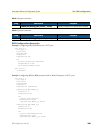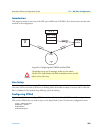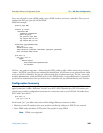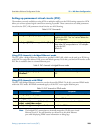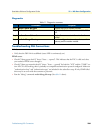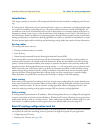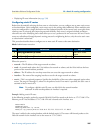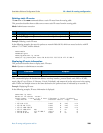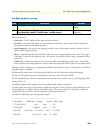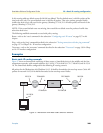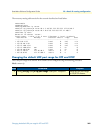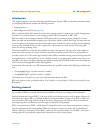
Introduction 236
SmartWare Software Configuration Guide 22 • Basic IP routing configuration
Introduction
This chapter provides an overview of IP routing and describes the tasks involved in configuring static IP rout-
ing.
IP routing moves information across an internetwork from a source to a destination, typically passing through
one or more intermediate nodes along the way. The primary difference between routing and bridging is the
two different access levels of information that are used to determine how to transport packets from source to
destination; routing occurs at Layer 3 (the network layer), while bridging occurs at Layer 2 (the link layer) of
the OSI reference model. In addition to transporting packets through an internetwork, routing involves deter-
mining optimal paths to a destination. Routing algorithms use metrics, or standards of measurement, to estab-
lish these optimal paths and for initializing and maintaining routing tables that contain all route information.
Routing tables
The routing table stores routes to:
• Directly-attached interfaces or networks
• Static IP routes
• Routes learned dynamically from the Routing Information Protocol (RIP)
In the routing table, next-hop associations specify that a destination can be reached by sending packets to a
next-hop router located on an optimal path to the destination. When the SmartNode receives an incoming
packet, it checks the destination address, and attempts to associate this address with a next-hop address and
outgoing interface. Routing algorithms must converge rapidly — i.e. all routers must agree on optimal routes.
When a network event causes routes either to go down or to become unavailable, routers distribute routing
update messages that permeate networks, causing recalculation of optimal routes that are eventually agreed
upon by all routers. Routing algorithms that converge slowly can cause routing loops or network outages.
Many algorithms can quickly select next-best paths and adapt to changes in network topology.
Static routing
Static routing involves packet forwarding on the basis of static routes configured by the system administrator.
Static routes work well in environments where network traffic is relatively predictable and where the network
topology is relatively simple. In contrast, dynamic routing algorithms adjust to changing network circum-
stances by analyzing incoming routing update messages. RIP uses dynamic routing algorithms.
Policy routing
IP routing makes decisions based on IP addresses. Policy Routing allows the user to configure IP routing based
on more criteria than only the destination IP address. Within the IP Context, IP packets are categorized into
traffic-classes which are used as a routing criterion. Three traffic-classes are defined—default, local-voice, and
local-default. In addition packets can be categorized into user-defined traffic-classes by using ACL.
Basic IP routing configuration task list
To configure IP routes, perform the tasks described in the following sections. The tasks in the first two sections
are required; the task in the remaining section is optional, but might be required for your application.
• Configuring static IP routes
• Deleting static IP routes (see page 238)



